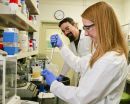(Press-News.org) What happens when a drought in Florida estuaries causes a rise in the salt levels in water? Fewer wild oysters appear on restaurant menus, for starters.
New research from Northeastern University marine and environmental sciences professor David Kimbro and graduate student Hanna Garland, published in PLOS ONE, links the deterioration of oyster reefs in Florida's Matanzas River Estuary (MRE) to a population outbreak of carnivorous conchs and high water salinity--or saltiness--caused by a prolonged regional drought.
This isn't just bad news for oyster lovers.
"Coastal ecosystems around the world depend greatly on the services provided by oysters," Kimbro said. "They are important for the stabilization of shorelines, filtration of coastal water, protection of important economically valuable fishes and invertebrates, and the removal of excess nitrogen."
As a result of degradation, overharvesting, and human activity, the global abundance of this habitat has declined by 85 percent, according to the Nature Conservancy. Today, most of the world's remaining reefs are concentrated in only six eco-regions--four in the United States.
"Luckily, there are government and non-government-led efforts that will begin to restore this habitat in 15 different states," Kimbro said. "But if an area to be restored contains or is likely to develop an outbreak of conchs like the one in Matanzas, then the restoration effort will fail, regardless of the expenditure of effort or expense, unless the salinity and conch problem is first solved."
When one of these eco-regions experiences an environmental stress, like that seen in the Floridian estuary, the impact can be felt across industry and ecosystems.
"Environmental change and consumer pressure--the conchs being the consumer--can impact foundation species like oysters on their own," Kimbro said. "But we have a case here where it is the interaction between the two stressors that is causing the greatest impact on the decline of the oysters."
The team found in this case that conchs reproduce better in water with a high salinity. Because of the deficit of freshwater and increase in salinity from the drought, conch larvae proliferated, resulting in an abundance of the conch, which then led to a greater consumption of oysters on the reef.
While the team determined the conch population outbreak to be the proximal cause of oyster loss, it is the salinity of the water spurred by the multi-year drought that is the ultimate cause, because that is what led to a spike in the carnivorous conch population.
Kimbro says there is optimism the reef could recover if the high salinization subsides. And a normalized conch population can actually be beneficial to oyster reproduction--after conchs pry open the oyster valves to consume the tissue inside, they leave behind a clean internal cavity, which oyster larvae can then use for its own development.
This research, along with additional studies on the conch-oyster dynamic in this eco-region could prove vital to oyster reef conservation efforts.
INFORMATION:
OAK RIDGE, Tenn., Aug. 14, 2015 - Another barrier to commercially viable biofuels from sources other than corn has fallen with the engineering of a microbe that improves isobutanol yields by a factor of 10.
The finding of the Department of Energy's BioEnergy Science Center, published in the journal Metabolic Engineering, builds on results from 2011 in which researchers reported on the first genetically engineered microbe to produce isobutanol directly from cellulose.
Isobutanol is attractive because its energy density and octane values are much closer to gasoline and ...
Americans favor diplomatic and economic strategies over military involvement in foreign policy, according to a new national survey conducted by The Associated Press-NORC Center for Public Affairs Research. Americans also question whether or not the United States should be the world's chief problem solver, even as a myriad of issues across the globe are identified as important for the next president to address. The nationwide poll of 1,167 adults collected data from June 25 to July 7 using AmeriSpeak, the probability-based panel of NORC at the University of Chicago. Interviews ...
Early-stage Non-small-cell Lung Cancer (NSCLC) is asymptomatic and difficult to detect since no blood test for NSCLC is currently available. In a new study, Chen-Yu Zhang and Chunni Zhang's group at Nanjing Advanced Institute for Life Sciences, Nanjing University identified a panel of five serum microRNAs (miRNAs) as the potential biomarker for NSCLC diagnosis.
The study is published this week in the journal EBioMedicine.
MiRNAs are a family of small, single-stranded non-coding RNAs that are critical regulators of numerous diseases, and their expression patterns have ...
Researchers at Columbia University's National Center for Disaster Preparedness (NCDP) and the University of Washington have published a new study focused on the public health implications of climate change. The article explores climate change impacts on human health in the U.S. Gulf Coast and has implications for this and other coastal regions that are particularly vulnerable to climate change. The study appears in the International Journal of Environmental Research and Public Health (August 11, 2015). The Open Access article is available here: http://bit.ly/1gAVqVe
This ...
Rockville, Md. -- A new study may have unlocked understanding of a mysterious part of the brain -- with implications for neurodegenerative conditions such as Alzheimer's. The results, published in Translational Vision Science & Technology (TVST), open up new areas of research in the pursuit of neuroprotective therapies.
Glaucoma is a neurodegenerative disease where patients lose seemingly random patches of vision in each eye. This random pattern of vision loss is in stark contrast to loss from a brain tumor or stroke, which causes both eyes to develop blind spots in the ...
The liver is unique among organs in its ability to regenerate after being damaged. Exactly how it repairs itself remained a mystery until recently, when researchers supported by the National Institutes of Health discovered a type of cell in mice essential to the process. The researchers also found similar cells in humans.
When healthy liver cells are depleted by long-term exposure to toxic chemicals, the newly discovered cells, known as hybrid hepatocytes, generate new tissue more efficiently than normal liver cells. Importantly, they divide and grow without causing cancer, ...
Physicists from Ludwig-Maximilians-Universität (LMU) in Munich studied the interaction of light with tiny glass particles.
A team of physicists and chemists from Ludwig-Maximilians-Universität Munich (LMU) and the Laboratory of Attosecond Physics (LAP) at the Max Planck Institute of Quantum Optics (MPQ), from the Institute of Physics of the University of Rostock, and from the Freie Universität Berlin studied the interaction between strong laser pulses and glass nanoparticles, which consist of multiple millions of atoms. Depending on how many atoms were ...
COLUMBUS, Ohio - Using a specially designed computational tool as a lure, scientists have netted the genomic sequences of almost 12,500 previously uncharacterized viruses from public databases.
The finding doubles the number of recognized virus genera - a biological classification one step up from species - and increases the number of sequenced virus genomes available for study almost tenfold.
The research group studies viruses that infect microbes, and specifically bacteria and archaea, single-cell microorganisms similar to bacteria in size, but with a different evolutionary ...
The once hurricane Hilda weakened to a remnant low pressure area early on Friday, August 14, 2015. Images generated from NOAA's GOES-West satellite were made into an animation that showed the "last Hoorah" of Hilda as it weakened into a low pressure area on August 14, south of the Big Island of Hawaii.
NOAA's GOES-West satellite sits in a fixed position over the eastern Pacific Ocean and monitors weather in the western U.S. and the central and eastern Pacific Ocean. Visible and infrared imagery from August 9 through August 14 were compiled and made into an animation at ...
August 14, 2015- Medicare patients in rural areas have lower rates of follow-up care after leaving the hospital--which may place them at higher risk of emergency department (ED) visits and repeat hospitalizations, according to a study in the September issue of Medical Care. The journal is published by Wolters Kluwer.
"This study provides evidence of lower rates of post-discharge follow-up care, and higher ED use for Medicare beneficiaries in rural settings," comments lead author Matthew Toth, PhD, MSW. The research was conducted while Dr. Toth was at University of North ...

